
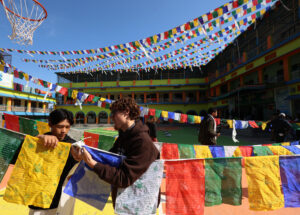
Today we visited a Tibetan children’s home located in Clement Town in Dehradun. Behind gates shrouded in prayer flags we were greeted with smiling faces and a full fledged band made up of flutes and drums. The children stood in a row and kindly placed a khatas ( a white scarf that signals welcoming or honor) around our necks. They directed us to write our first and last names on the khatas, tying them to strings of prayer flags before hoisting them up into the sea of rainbow cloth decorating the sky above. We were told by the director of the school that hanging the khatas was good luck.
After hanging our khatas, we began mingling with the students who then gave us a tour of the surrounding area including a Tibetan temple. I was guided by an eighth grader who was very talkative. We immediately clicked as we soon came to find out that we both loved reading a lot of the same books. In fact, I have my sister to thank for being able to connect so well with a lot of the girls at the school. K-pop, K-dramas, anime, and manga is very big at the Tibetan children’s school and whether by choice (or by force) I have been exposed to a plethora of Korean and Japanese pop culture.
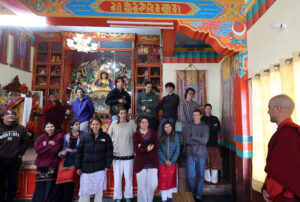
Once back at their school, we were able to tour their school and visit the futsal court. We took turns trying to shoot goals against one of the school children in which I am proud to say that I was the only one who scored. At the end of our visit we had a dance exchange, MMS students performing the invocation from the Ramayana and the Tibetan children performing two of their own dances. It was inspiring to see how much of the Tibetan culture has been preserved in the children. Most of them know at least five languages and they are all immersed in cultural practices such as dance and prayer.
Our next stop of the day was at the Drikung Nunnery. We were led around the nunnery visiting the prayer room and retreat rooms. As we drank tea and nibbled on cookies we were offered a large history of Buddhism in Tibet and India such as the Nalanda university and the Buddhist emperor Ashoka. I was particularly enthralled with the whole experience having attended a Buddhist summer camp at Vajrapani institute near my house when I was young. I could feel myself clinging to every word that the monks, nuns, and main coordinator had to say about Buddhism. During our free discussion time, I asked one of the monks about the deity Tara, who, during my time at Vajripani institute, was my favorite. He was happy to give me an expansive summary of her symbolism and explain in which circumstances one calls on her. Later, at the partnering Monastery, he personally showed me the small temple dedicated to Tara.
As we watched the skillfully painted temple fade into the distance, I reflected on the teachings I learned. The lesson that resonated with me the most is that Buddhism is not a religion but a way of life. As such, Christianity or any belief system can co-exist with Buddhism. And, as we drove up the scary road to Mussoorie, I called on Tara, to help me face the obstacle ahead.
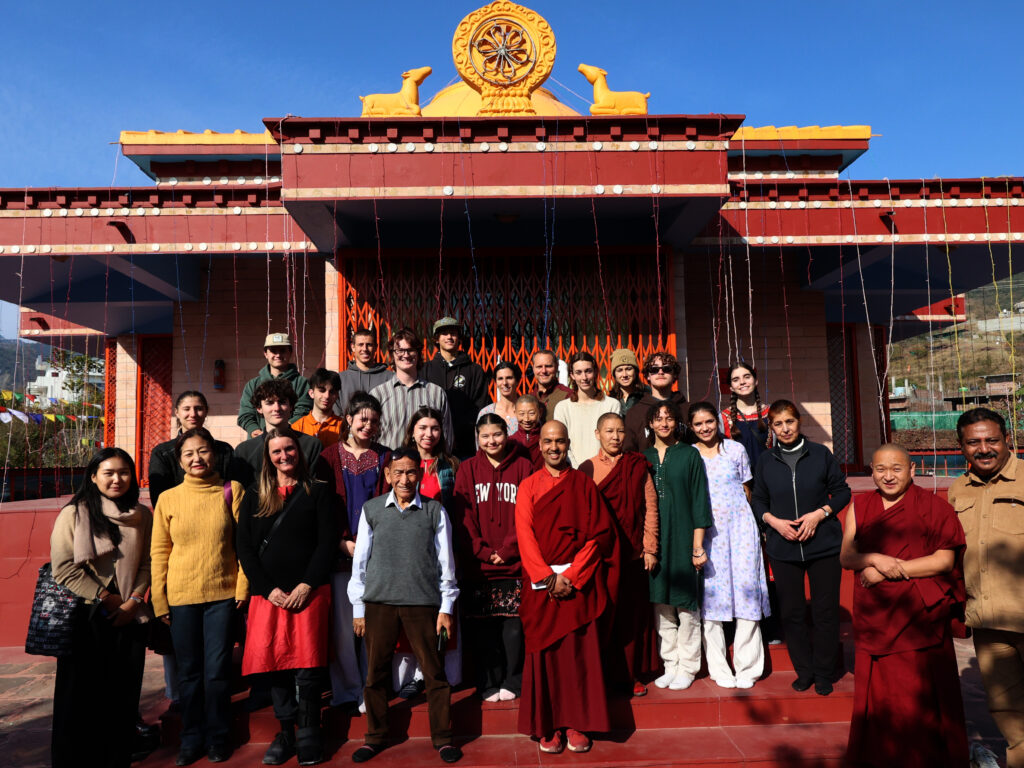

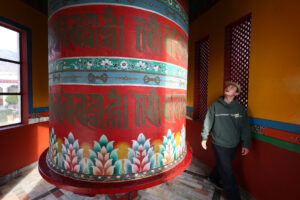
The Tibetan Children’s Home seemed like one of the happiest places on earth. Getting off the bus, I saw the many flowers that bloomed around the area. Dogs and puppies ran around playing in the streets as people walked on the sidewalks. When I walked in through the gate into the colorful courtyards of The Tibetan Children’s Home, children from all different age groups were playing drums and flutes. In the sky, thousands of colorful prayer flags were hung from the buildings, creating a beautiful swooping shape. On the side of the courtyard, a line of younger children with white scarves waited patiently. I watched as my classmates in front of me were given a scarf, bending over to receive it on their necks. The scarves, we were told, were used for good luck. By writing your name on the scarf and tying it up with the prayer flags, good luck will follow you.
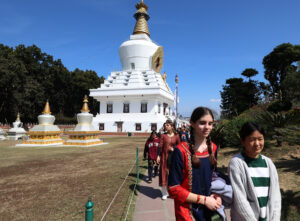
After our lovely welcoming, we got to walk around the area and we visited two mosques and monasteries. In both, we saw huge golden statues that seemed to reach to the sky. Many flowers were growing alongside the pathways of the monastery. The whole time, a girl from The Tibetan Children’s Home, who was in the 8th grade was walking with me, hand in hand talking about things like our favorite music and what we like to do in our free time. On the right side of the path followed was a wall with hundreds of golden cylinder-shaped cylinder wheels that spin around in a circle. The girl explained to me that these were prayer wheels and that you can only spin them clockwise, otherwise it is unlucky. She then took me to a huge prayer wheel that was red, green, and white. This one, we spun together, holding onto a silver metal bar and walking around the big cylinder clockwise.
We then walked back to The Tibetan Children’s Home where the same girl showed me around. I walked into her room she was sharing with many other girls from 5th grade to 8th grade and I was shocked at how clean and tidy it was. All of their blankets were neatly folded at the end of their beds and their books were neatly put into the shelf. In the room, we had a little dance party. Lots of girls gathered to watch as people showed off their dances. Me and a couple of my classmates danced to the song “My Desi Girl” which we learned at the Sri Ram Ashram not too long ago, and they loved it. As everyone got into the middle of the floor to perform their dance, everyone was supporting them. From clapping to the beat to audibly cheering them on, everyone was involved in every dance. Here, I felt very connected to my girlhood, dancing around and living in the present moment. I will never forget this exciting experience that I was so lucky to have had.
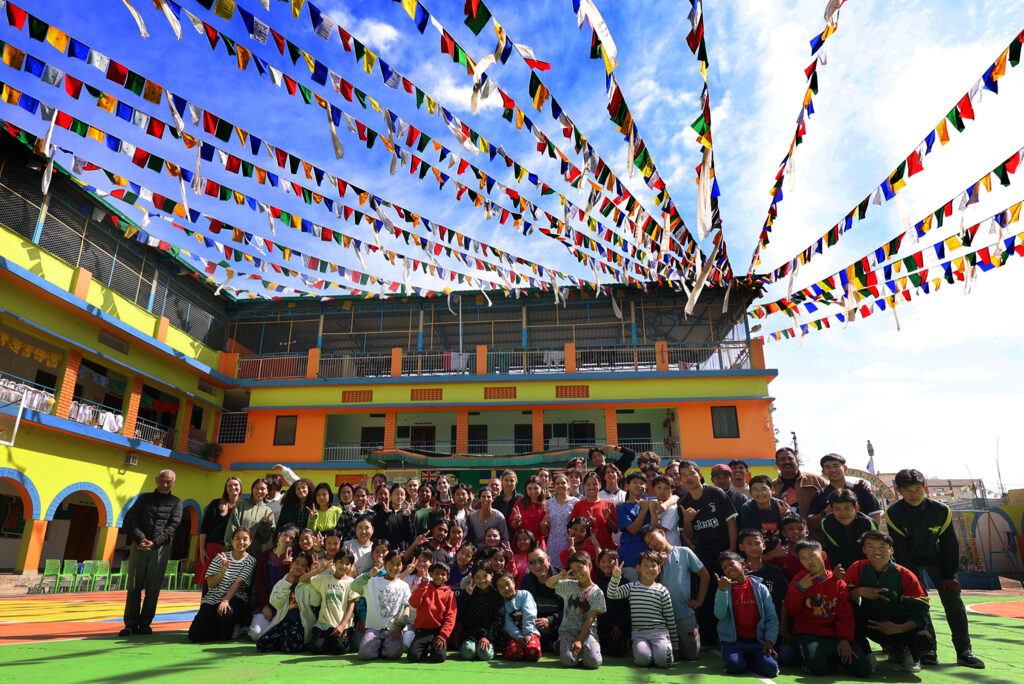

I hold a profound admiration for Buddhist philosophies, often immersing myself in books and teachings about Buddhism. Therefore, upon our trip to India, the awaitment of visiting Buddhist monasteries and engaging with monks filled me with excitement.
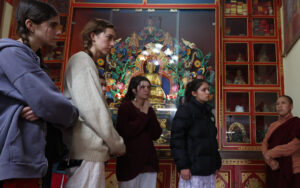
After our first visit to The Mindrolling monastery, I felt so much inspiration because I was learning about philosophies I admire and was visually seeing statues and art that represent concepts that I take much wonder in. Following the monastery, we went to the Drikung nunnery, an experience I approached with curiosity because I genuinely did not know what to expect. Welcomed by a Monk named Sonam Tsetan, he graciously guided us through the nunnery, introducing us to the prayer rooms and sharing the history of Buddhism.
During our tour, an older man would interrupt Sonam Tsetan with impassioned explanations of Buddhist concepts, captivating everyone with the way he spoke and how he carried the strength behind his words. His vivid descriptions, accompanied by animated gestures, resonated deeply with me.
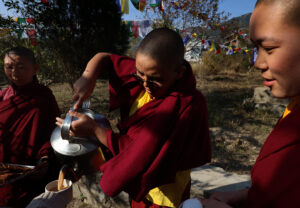
We walked into a small room with a 3D mandala inside, repressing the mind. After Sonam Tsetan explained to us what it meant, I asked him a clarifying question in which the older man interrupted and answered. While answering, he urged me to close my eyes and look within, leading to a realization about the nature of the mind. This interaction with him was an incredible experience. While my eyes were closed, he asked me what I saw, which I had no way of answering what I saw with eyes closed. His way of teaching is completely immersive.
Afterward, we drank chai outside while everyone was talking to the different monks. I was nervous to speak to the older man because his intelligence intimidated me. When I finally did, I asked him about one of Buddha’s teachings that I read months ago yet found myself confused by. His passionate explanations of Buddha’s teaching led to explanations of various teachings on concepts like karma, forgiveness, desire, suffering, and the mind left an indelible impression on me. As our discussion concluded, he symbolically bestowed upon me an imaginary key, along with his blessings. Although I’m not sure what the imaginary key he gave me meant, or what it was for, it is a gesture that I will forever cherish as a token of compassion and wisdom.
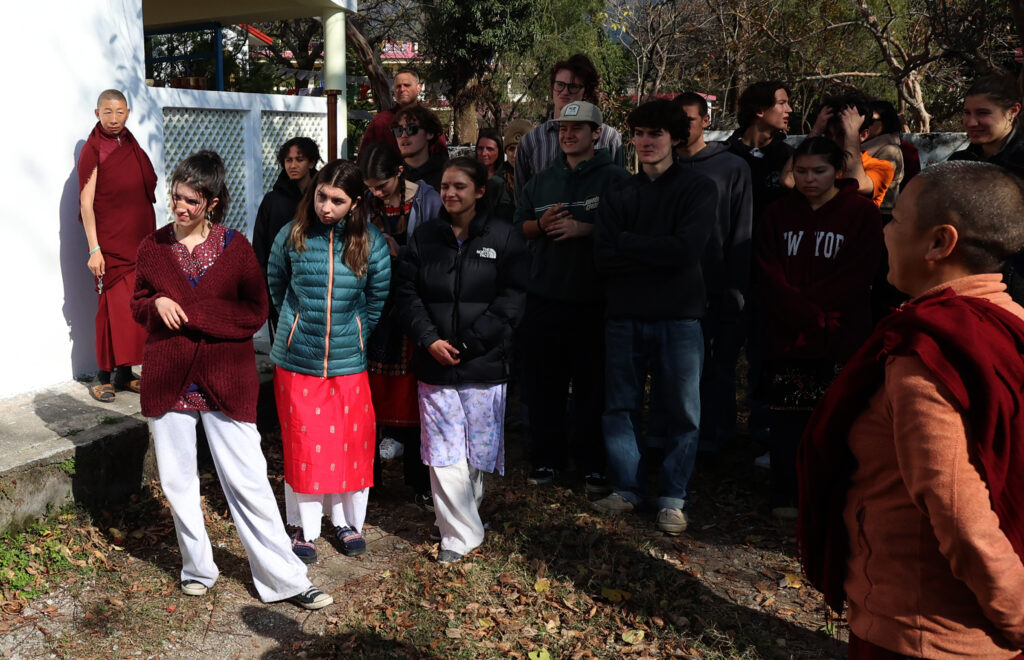
You must be logged in to post a comment.